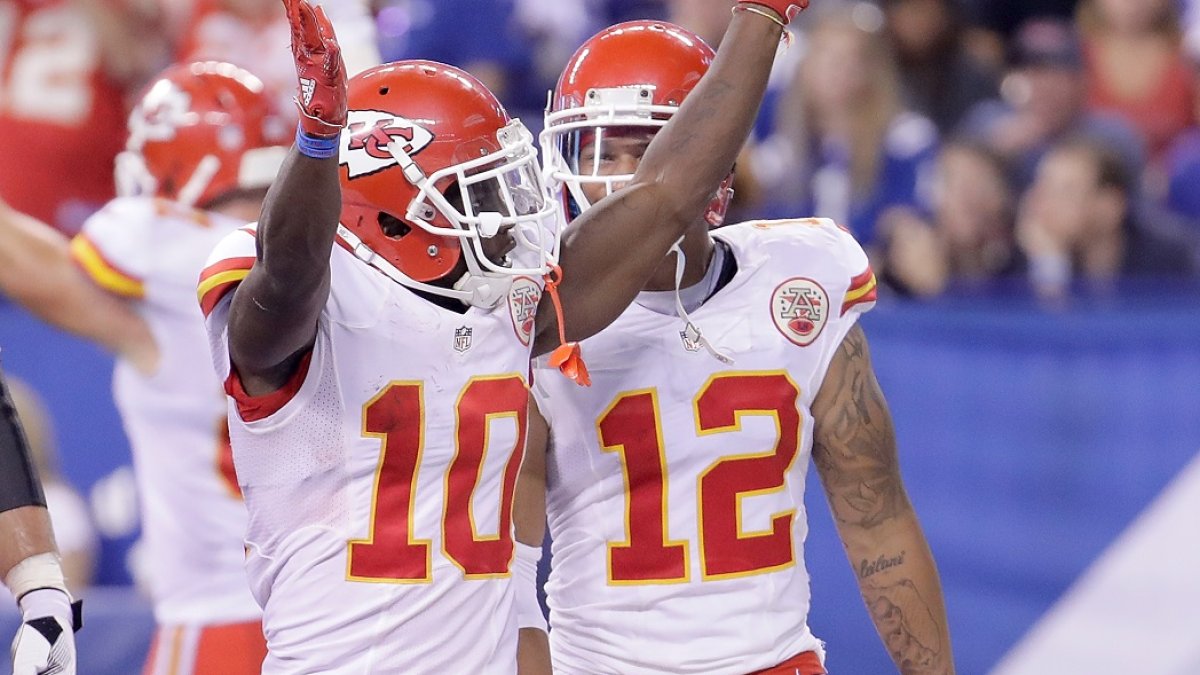(“Today's Crazy Fantasy Stat” is an occasional offseason offering from PFF that highlights something that catches our eye and aids in our preparation for the 2017 fantasy season.)
Fantasy aside, as football fans, we love it when guys do things that aren’t expected for their “type.” Dontari Poe throwing a pass. Ndamukong Suh kicking a field goal. Heck, it isn’t special to football. Just check out Twitter when a position player pitches in baseball, or a 7-foot-3 center suddenly has to throw up a desperation three-pointer. These instances rarely work out well, but man, do we get excited.
That’s part of why it was so exciting watching Tyreek Hill in 2016. He had a good season — 866 yards from scrimmage, another 976 on returns, 12 total touchdowns, fantasy’s WR15 — but by headlines and highlights, he had to be top-five. He was a wide receiver rushing the ball, returning kicks, scoring for your fantasy team in ways not many guys have done in the past, and that’s exciting. Doubly so when it works.
Thing is, we’ve seen these guys before. Percy Harvin, Cordarrelle Patterson, Tavon Austin have all had seasons where a big chunk of their fantasy numbers came through rushing work, either on designed runs, screen passes that became laterals, trick players, what-have-you. Hill isn’t the first of his kind, even if it’s a limited kind overall.
(Subscribe to all our fantasy content, or get everything PFF offers with an All-Access subscription.)
But check out those names again. How much staying power is there? Patterson and Austin are still playing, of course, but neither has huge fantasy relevance right now. Harvin’s career was cut short by injury, and he was one of those “burn fast and bright” types. So what can we expect out of Hill? Is he going to continue to be a gadget-style player, putting up fantasy points on the ground enough to be worth an investment even if he doesn’t have massive receiving numbers?
To test this, I took every top-50 wide receiver season in the last 10 years and calculated the percentage of their fantasy points scored on the ground. In that sample, the highest percentage of fantasy points gained on the ground by a receiver was Austin, in 2015, as he put up 46.8 percent of his season total in ground work. Hill’s 2016 season ranks fourth, at 31.9 percent. Harvin has three of the top 12, four of the top 16 seasons on the list.
The real question, then — can they keep it up? Is it predictable?
The top 50 on the list — handily enough, every player with 4.0 or more percent of his fantasy production on the ground — averaged 10.8 percent ground production. The season following, 41 of those names — excepting the six 2016 players and three who didn’t play the next year — averaged 6.1 percent. On top of that, as a group, the group fell off by better than 20 fantasy points per person.
Because that’s a lot of numbers, here’s a chart! Aren’t charts wonderful:
| Top-50 receivers with heavy ground production, 2007-2016 | |||
| Year n | Year n+1 | % difference | |
| Average fantasy production | 124.3 | 102.32 | -17.70% |
| Average % fantasy points on the ground | 10.8 | 6.1 | -43.52% |
That’s a big group, though, and includes everyone from Jerricho Cotchery, who had two rushes for 7 yards and a touchdown in 2009, which accounted for 6.3 percent of his scoring, to the aforementioned Harvin, Patterson, and Austin.
So I looked higher on the list, for standouts who maintained strong year-over-year production. And that list is basically Harvin, full stop. Tavon Austin put up plenty of ground production in 2016 (24.3 percent of his scoring), but it was a far cry from the 46.8 percent 2015, when he was actually fantasy-relevant. But Harvin had 10-plus percent of his fantasy numbers on the ground four straight years, 2009-2012, and actually increased year-over-year 2009-10 and 2010-11.
In the last decade, five wide receivers have put up 20 or more percent of their fantasy totals through rushing — 2015 Austin, 2013 Patterson, 2010 Jacoby Ford, 2016 Hill, and 2011 Harvin. They were each special seasons, given the pedigrees of the players in question. No one on the list has ever had a better season, before or since (so far, in the case of the still-active guys).
There’s a reason for that: the guys who rank highly here are the ones with rushing scores (six receivers have two-plus rush TDs in the last decade, and those are the top six in the rankings), and touchdown production is notoriously fickle. But that’s exactly the point — touchdowns are fickle. Hill scored three rushing touchdowns in 2016. Yes, it’s possible that happens again. But counting on that is a fool’s errand.
The Chiefs have Hill, Travis Kelce, and Spencer Ware still around. Jeremy Maclin should be healthier in 2017. Draft pick RB Kareem Hunt was used in a lot of ways in college, and Jehu Chesson was also drafted. The offense is not vintage Packers-level, but it has weapons. Hill might get utilized more in the passing game just on the backs of his productive 2016, but at the same time, Maclin, Hunt, and Chesson could cannibalize his workload.
In the end, draft Hill for 2017 if you want. But do it because you believe in his receiving skills. We know how fickle kick returning is, and for receivers, rushing can be just as fickle. Draft him to catch passes, and the rest is gravy.




 © 2025 PFF - all rights reserved.
© 2025 PFF - all rights reserved.